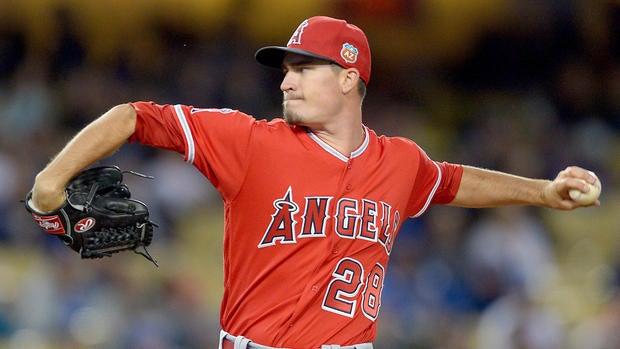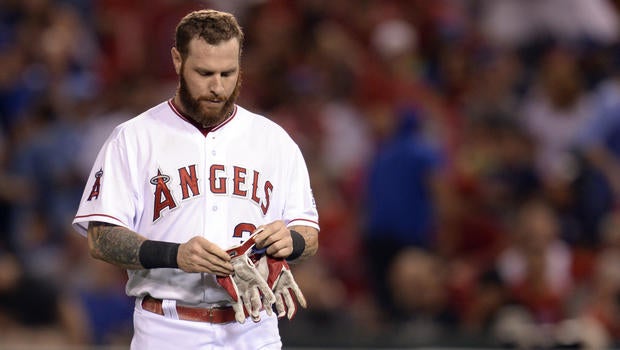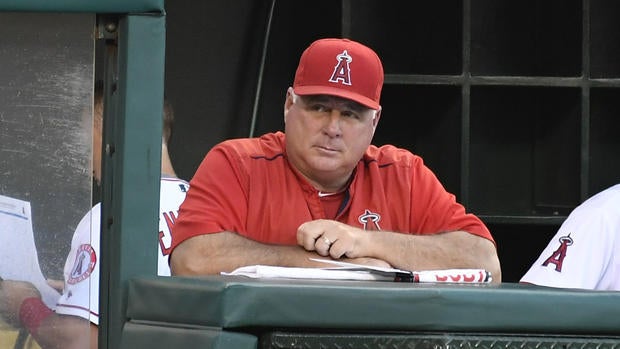Six reasons the Angels look like the most hopeless franchise in baseball – CBSSports.com
Things just keep going from bad to worse for the
Los Angeles Angels
. Monday night they lost their 11th consecutive game, this one to the
Seattle Mariners
(SEA 3, LAA 2), giving them a 49-69 record for the season. Never before has a Mike Scioscia team been this bad.
The Angels are 20 games under. 500 for the first time in Mike Scioscia’s 17-year tenure as manager.
— Bill Shaikin (@BillShaikin) August 16, 2016
Not only are the Angels bad at the big league level, but they also have what is widely considered the very worst farm system in baseball. Before the season Baseball Prospectus said the Halos “lack anything with even remote projection to impact talent” in the system. ESPN’s Keith Law called it “by far the worst system I’ve ever seen.” The Angels did just add some talent through the 2016 amateur draft, though not enough to make a real difference.
The Angels look so hopeless right now that it almost gives me anxiety. How are they doing to turn this around and build a contender? There’s so much work to be done! It looks like it’s going to take years and years to get this team back into contention. Even with
Mike Trout
, the big league roster is short on core-caliber talent, and the farm system offers zero immediate help. New GM Billy Eppler has his work cut out for him, for sure.
How exactly did the Angels get here? Why is the big league roster so short on non-Trout impact talent, and why is the farm system the worst in baseball? It takes a series of bad decisions plus some bad luck for an organization to fall into a hole this deep. Here are six reasons why the Angels are where they are.
1. Their young pitchers keep getting hurt

Despite lacking the minor league talent to go out and make an impact trade, I thought former GM Jerry Dipoto did a really nice job importing high-end young pitching talent the last few years. The problem is these guys keep getting hurt. We’re talking significant arm injuries too. Look:
- LHP
Tyler Skaggs
: Had Tommy John surgery in August 2014. - LHP
Andrew Heaney
: Had Tommy John surgery in July 2016. - RHP
Nick Tropeano
: Had Tommy John surgery in August 2016. - RHP
Garrett Richards
: Torn knee tendon in August 2014. Currently trying to avoid Tommy John surgery with an alternative stem-cell treatment.
I suppose the good news is Skaggs returned from elbow reconstruction a few weeks ago and has generally looked fantastic following a long rehab. Richards was recently cleared the throw after tests showed “significant improvement” in his elbow.
The bad news is Heaney and Tropeano just had Tommy John surgery within the last few weeks, meaning if they do return next season, it won’t be until very late in the second half. More than likely those two are looking at a 2018 return. And we still don’t know how well this stem-cell treatment will work for Richards. The early returns are promising, but he still has a long way to go before he gets back on an MLB mound.
Point is, the Angels have seen their best young pitchers all suffer serious injuries within the last two calendar years, many of them arm-related. The rotation has taken a hit and the team is losing out on several cheap years of team control. Those are the backbone of any forward-moving organization.
2. Their big contracts have gone bad
The Angels are paying four players more than $20 million this season. Those four players have combined for -0.2 WAR. One of them isn’t even on the roster anymore. Look at all this dead money:
Hamilton, of course, plays for the division rival
Texas Rangers
now. Well, it’d be more accurate to say he sits on their DL, not plays for them. And yes, that $26.41 million is what the Angels are actually paying him. The Rangers are paying the other $2 million of Hamilton’s $28.41 million salary.
The Halos are paying almost $100 million to get replacement level production from those four players. Hamilton and Wilson got hurt, Pujols is declining, and Weaver now has a fastball you catch with your teeth. The Angels signed Hamilton, Pujols, and Wilson expecting to get a few elite or nearly elite seasons from them. Weaver was extended at big money for the same reason. Those deals have backfired horribly.

3. They’ve forfeited too many draft picks
All those big money contracts cost the team high draft picks in 2012 and 2013. The Angels did not have a first or second round pick in 2012 due to the Pujols and Wilson signings, and they didn’t have a first round pick in 2013 either due to the Hamilton signing. That’s three high draft picks surrendered as free agent compensation in a short period of time. It’s close to impossible to build a respectable farm system without first (and second) round picks.
4. Their drafts have been unproductive
Even when the Angels have had a first round pick, they haven’t exactly knocked it out of the park in the draft. Since taking Trout in the first round in the 2009 draft, the Halos have drafted and developed two regulars:
Kole Calhoun
(eighth round in 2010) and
C.J. Cron
(first round in 2011). That’s it.
The team’s 2013 draft is already close to a total loss. They forfeited their first rounder to sign Hamilton, their second rounder (
Hunter Green
) is already out of baseball, their third rounder (Keynan Middleton) has a 5.46 ERA in 278 1/3 pro innings, their fourth rounder (
Elliot Morris
) has a 4.87 ERA above Single-A, and their fifth rounder (
Kyle McGowin
) has a 4.71 ERA in 357 1/3 pro innings.
The only potential saving grace from that 2013 draft is lefty
Nate Smith
, who MLB.com ranks as the team’s fifth best prospect. Their scouting report says he has the ceiling of a “No. 4 or 5 starter.” It’s no surprise then that the Angels fired scouting director Ric Wilson earlier this month. Their drafts have been wholly unproductive.
Rick Wilson’s best signs (’11-’16), by WAR
Cron 1.4
Bandy 1.2
Mahle -0.3
Clevinger -0.4
Morin -0.5— Nate Aderhold (@NateAderhold) August 4, 2016
Now, to be fair, the jury is still out on the most recent drafts. The Angels did trade their first (
Sean Newcomb
) and third (
Chris Ellis
) round picks in the 2014 draft for
Andrelton Simmons
over the winter, so at least those players were useful in some way. There still has not been nearly enough help coming from within. Not enough to help mitigate the disastrous big money signings.
5. They’ve punted the international market
A few years ago the current collective bargaining agreement implemented draft and international free agent spending restrictions. Teams are giving a bonus pool each year, and if they exceed that pool, they face harsh penalties. It’s a good way for owners to sell money.
Last January the Angels blew their $2.383 million bonus pool out of the water by signing Cuban infielder
Roberto Baldoquin
to an $8 million bonus. As a result, they had to pay a 100 percent tax on the overage (so $5.617 million) and are not allowed to sign a player for more than $300,000 during the 2015-16 and 2016-17 international signing periods.
That $300,000 limit takes the Angels right out of the running for top international players. They’ve been unable to add talent that way. And, to make matters worse, Baldoquin isn’t even that good of a prospect. MLB.com ranks him as the No. 22 prospect in a bad Angels system. Here’s a piece of their scouting report:
Baldoquin had a weird hitch at the top of his load, something he’s worked to fix so he can catch up to better velocity. He will have to continue to refine his approach and cut down on his strikeouts. The shortstop worked hard with Inland Empire manager Denny Hocking on his footwork, the cause of most of his first-half throwing errors … The Angels are still hopeful Baldoquin’s can put it together, but he’ll have to bounce back from his struggles first. Whether he profiles as an everyday shortstop or ends up a utility type remains to be seen.
Ouch. The Angels blew up their bonus pool and took themselves out of the running for top international talent for two signing periods to sign someone who might be a utility guy. Forfeiting high draft picks and being unable to reel in top international players is a great way to wind up with the worst farm system in baseball.
6. Scioscia has too much control

I am a big believer in managers having a shelf life. It’s different for everyone. Sometimes it might be three years, sometimes it might be five, sometimes it might be 12. It’s different for everyone, and it depends on the manager himself as well as the personnel around him.
Eventually the methods and the message get stale though. It happens to everyone. The Angels seem to be at that point with Scioscia, who has been the skipper since 2000. It’s not just that he’s been calling the shot for 17 seasons either. Scioscia clearly has a lot of pull in the organization. Perhaps too much pull.
Remember, Dipoto resigned last year because he was losing a power struggle with Scioscia. Owner Arte Moreno sided with the manager, so Dipoto walked away. When’s the last time a GM just walked away like that? It never happens. Scioscia has input into pretty much everything, including roster moves and potential acquisitions.
It seems to be too much power for a manager. The front office has to be able to do its thing without interference from the dugout. The fact Moreno has Scioscia’s back doesn’t help matters either. The manager has to manage and the front office has to worry about everything else. There should be this much overlap.
It may be time for the Angels to bring a new voice with fresh ideas. Would they actually fire Scioscia? I’ll believe it when I see it, but when the team is 49-69 and looks as far away from contention as the Halos do right now, I wouldn’t rule anything out.



